Recruitment and Selection: Analysis of Recruitment Processes
VerifiedAdded on 2020/01/21
|9
|2561
|73
Report
AI Summary
This report provides a detailed analysis of recruitment and selection processes within organizations, focusing on two case studies: Luton and Tesco. It begins by identifying and comparing the recruitment plans of these companies, highlighting their approaches to workforce planning, advertising, and internal versus external recruitment strategies. The report then explores the impact of legal and regulatory frameworks, such as the Data Protection Act and the Sex Discrimination Act, on recruitment activities, emphasizing the importance of ethical and legal compliance. Furthermore, it outlines the documents used in selection and recruitment, including job descriptions, person specifications, and job advertisements, providing examples. The study then delves into the planning and execution of selection interviews, including ethical considerations and sample questions for both entry-level and experienced candidates. In conclusion, the report emphasizes the importance of adhering to legal regulations and selecting candidates based on expertise, skills, and knowledge, offering a comprehensive overview of the recruitment and selection process.

RECRUITMENT AND SELECTION
RECRUITMENT AND SELECTION
Student Name:
Student ID Number:
Subject Title:
AQF Level:
Word count: 2000
Page 1 of 9
RECRUITMENT AND SELECTION
Student Name:
Student ID Number:
Subject Title:
AQF Level:
Word count: 2000
Page 1 of 9
Paraphrase This Document
Need a fresh take? Get an instant paraphrase of this document with our AI Paraphraser
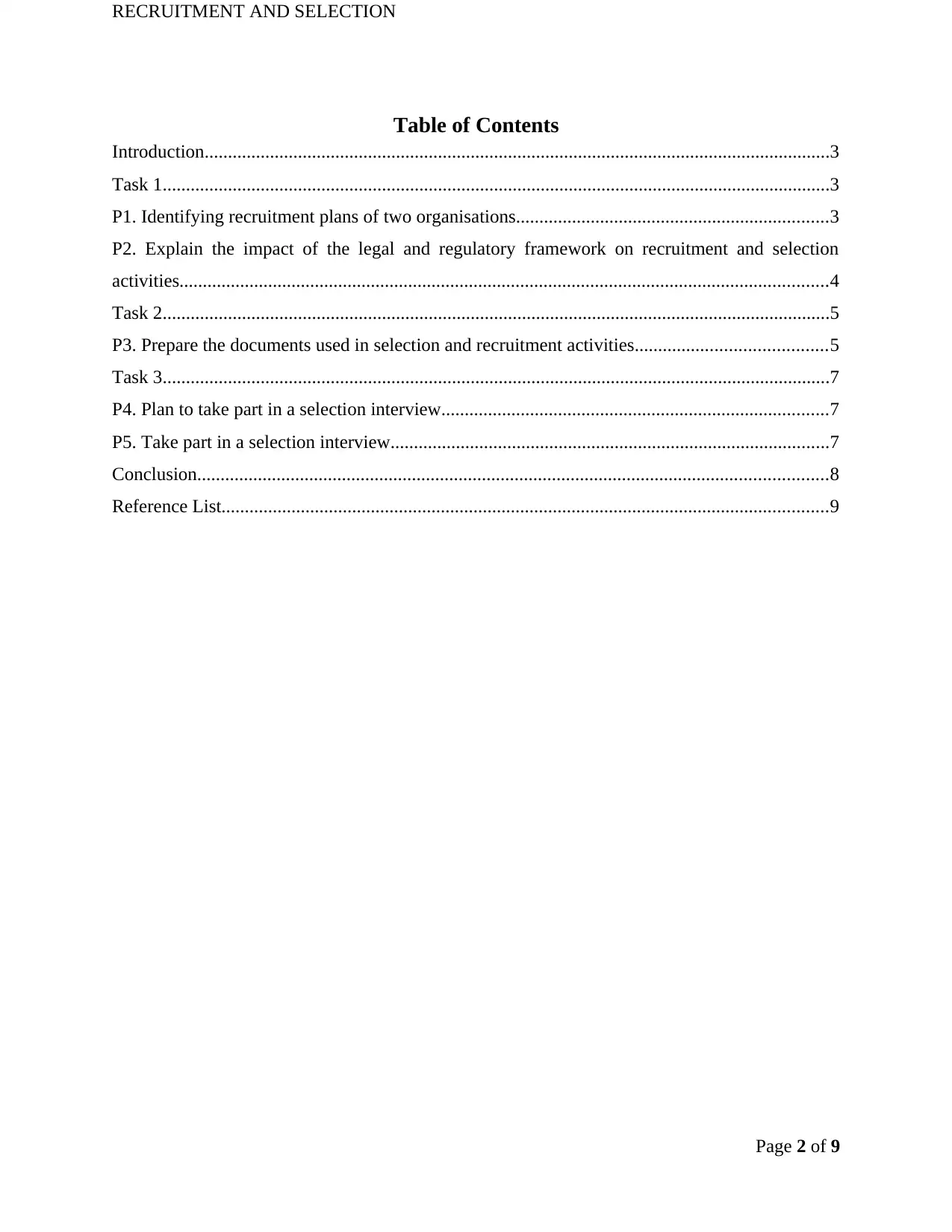
RECRUITMENT AND SELECTION
Table of Contents
Introduction......................................................................................................................................3
Task 1...............................................................................................................................................3
P1. Identifying recruitment plans of two organisations...................................................................3
P2. Explain the impact of the legal and regulatory framework on recruitment and selection
activities...........................................................................................................................................4
Task 2...............................................................................................................................................5
P3. Prepare the documents used in selection and recruitment activities.........................................5
Task 3...............................................................................................................................................7
P4. Plan to take part in a selection interview...................................................................................7
P5. Take part in a selection interview..............................................................................................7
Conclusion.......................................................................................................................................8
Reference List..................................................................................................................................9
Page 2 of 9
Table of Contents
Introduction......................................................................................................................................3
Task 1...............................................................................................................................................3
P1. Identifying recruitment plans of two organisations...................................................................3
P2. Explain the impact of the legal and regulatory framework on recruitment and selection
activities...........................................................................................................................................4
Task 2...............................................................................................................................................5
P3. Prepare the documents used in selection and recruitment activities.........................................5
Task 3...............................................................................................................................................7
P4. Plan to take part in a selection interview...................................................................................7
P5. Take part in a selection interview..............................................................................................7
Conclusion.......................................................................................................................................8
Reference List..................................................................................................................................9
Page 2 of 9
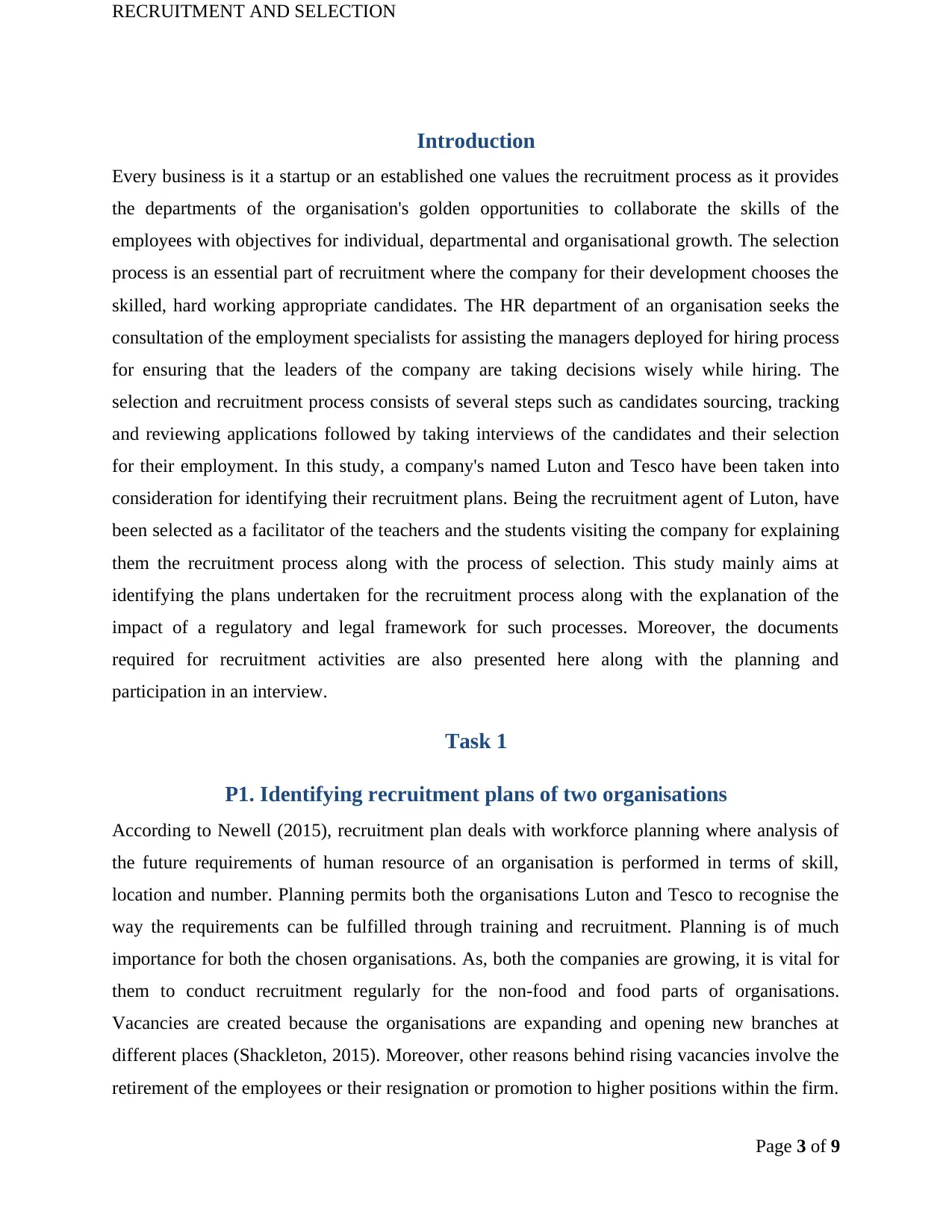
RECRUITMENT AND SELECTION
Introduction
Every business is it a startup or an established one values the recruitment process as it provides
the departments of the organisation's golden opportunities to collaborate the skills of the
employees with objectives for individual, departmental and organisational growth. The selection
process is an essential part of recruitment where the company for their development chooses the
skilled, hard working appropriate candidates. The HR department of an organisation seeks the
consultation of the employment specialists for assisting the managers deployed for hiring process
for ensuring that the leaders of the company are taking decisions wisely while hiring. The
selection and recruitment process consists of several steps such as candidates sourcing, tracking
and reviewing applications followed by taking interviews of the candidates and their selection
for their employment. In this study, a company's named Luton and Tesco have been taken into
consideration for identifying their recruitment plans. Being the recruitment agent of Luton, have
been selected as a facilitator of the teachers and the students visiting the company for explaining
them the recruitment process along with the process of selection. This study mainly aims at
identifying the plans undertaken for the recruitment process along with the explanation of the
impact of a regulatory and legal framework for such processes. Moreover, the documents
required for recruitment activities are also presented here along with the planning and
participation in an interview.
Task 1
P1. Identifying recruitment plans of two organisations
According to Newell (2015), recruitment plan deals with workforce planning where analysis of
the future requirements of human resource of an organisation is performed in terms of skill,
location and number. Planning permits both the organisations Luton and Tesco to recognise the
way the requirements can be fulfilled through training and recruitment. Planning is of much
importance for both the chosen organisations. As, both the companies are growing, it is vital for
them to conduct recruitment regularly for the non-food and food parts of organisations.
Vacancies are created because the organisations are expanding and opening new branches at
different places (Shackleton, 2015). Moreover, other reasons behind rising vacancies involve the
retirement of the employees or their resignation or promotion to higher positions within the firm.
Page 3 of 9
Introduction
Every business is it a startup or an established one values the recruitment process as it provides
the departments of the organisation's golden opportunities to collaborate the skills of the
employees with objectives for individual, departmental and organisational growth. The selection
process is an essential part of recruitment where the company for their development chooses the
skilled, hard working appropriate candidates. The HR department of an organisation seeks the
consultation of the employment specialists for assisting the managers deployed for hiring process
for ensuring that the leaders of the company are taking decisions wisely while hiring. The
selection and recruitment process consists of several steps such as candidates sourcing, tracking
and reviewing applications followed by taking interviews of the candidates and their selection
for their employment. In this study, a company's named Luton and Tesco have been taken into
consideration for identifying their recruitment plans. Being the recruitment agent of Luton, have
been selected as a facilitator of the teachers and the students visiting the company for explaining
them the recruitment process along with the process of selection. This study mainly aims at
identifying the plans undertaken for the recruitment process along with the explanation of the
impact of a regulatory and legal framework for such processes. Moreover, the documents
required for recruitment activities are also presented here along with the planning and
participation in an interview.
Task 1
P1. Identifying recruitment plans of two organisations
According to Newell (2015), recruitment plan deals with workforce planning where analysis of
the future requirements of human resource of an organisation is performed in terms of skill,
location and number. Planning permits both the organisations Luton and Tesco to recognise the
way the requirements can be fulfilled through training and recruitment. Planning is of much
importance for both the chosen organisations. As, both the companies are growing, it is vital for
them to conduct recruitment regularly for the non-food and food parts of organisations.
Vacancies are created because the organisations are expanding and opening new branches at
different places (Shackleton, 2015). Moreover, other reasons behind rising vacancies involve the
retirement of the employees or their resignation or promotion to higher positions within the firm.
Page 3 of 9
⊘ This is a preview!⊘
Do you want full access?
Subscribe today to unlock all pages.

Trusted by 1+ million students worldwide
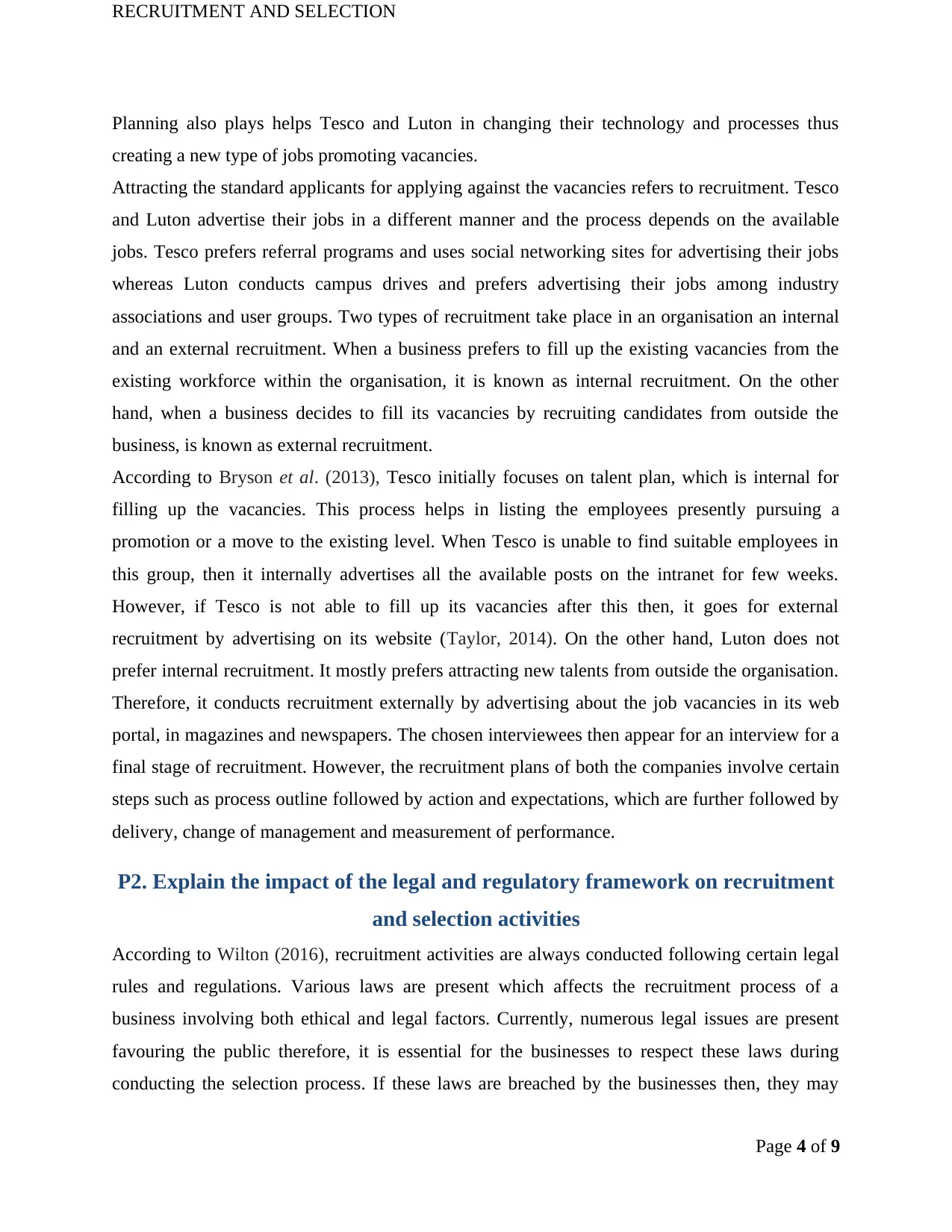
RECRUITMENT AND SELECTION
Planning also plays helps Tesco and Luton in changing their technology and processes thus
creating a new type of jobs promoting vacancies.
Attracting the standard applicants for applying against the vacancies refers to recruitment. Tesco
and Luton advertise their jobs in a different manner and the process depends on the available
jobs. Tesco prefers referral programs and uses social networking sites for advertising their jobs
whereas Luton conducts campus drives and prefers advertising their jobs among industry
associations and user groups. Two types of recruitment take place in an organisation an internal
and an external recruitment. When a business prefers to fill up the existing vacancies from the
existing workforce within the organisation, it is known as internal recruitment. On the other
hand, when a business decides to fill its vacancies by recruiting candidates from outside the
business, is known as external recruitment.
According to Bryson et al. (2013), Tesco initially focuses on talent plan, which is internal for
filling up the vacancies. This process helps in listing the employees presently pursuing a
promotion or a move to the existing level. When Tesco is unable to find suitable employees in
this group, then it internally advertises all the available posts on the intranet for few weeks.
However, if Tesco is not able to fill up its vacancies after this then, it goes for external
recruitment by advertising on its website (Taylor, 2014). On the other hand, Luton does not
prefer internal recruitment. It mostly prefers attracting new talents from outside the organisation.
Therefore, it conducts recruitment externally by advertising about the job vacancies in its web
portal, in magazines and newspapers. The chosen interviewees then appear for an interview for a
final stage of recruitment. However, the recruitment plans of both the companies involve certain
steps such as process outline followed by action and expectations, which are further followed by
delivery, change of management and measurement of performance.
P2. Explain the impact of the legal and regulatory framework on recruitment
and selection activities
According to Wilton (2016), recruitment activities are always conducted following certain legal
rules and regulations. Various laws are present which affects the recruitment process of a
business involving both ethical and legal factors. Currently, numerous legal issues are present
favouring the public therefore, it is essential for the businesses to respect these laws during
conducting the selection process. If these laws are breached by the businesses then, they may
Page 4 of 9
Planning also plays helps Tesco and Luton in changing their technology and processes thus
creating a new type of jobs promoting vacancies.
Attracting the standard applicants for applying against the vacancies refers to recruitment. Tesco
and Luton advertise their jobs in a different manner and the process depends on the available
jobs. Tesco prefers referral programs and uses social networking sites for advertising their jobs
whereas Luton conducts campus drives and prefers advertising their jobs among industry
associations and user groups. Two types of recruitment take place in an organisation an internal
and an external recruitment. When a business prefers to fill up the existing vacancies from the
existing workforce within the organisation, it is known as internal recruitment. On the other
hand, when a business decides to fill its vacancies by recruiting candidates from outside the
business, is known as external recruitment.
According to Bryson et al. (2013), Tesco initially focuses on talent plan, which is internal for
filling up the vacancies. This process helps in listing the employees presently pursuing a
promotion or a move to the existing level. When Tesco is unable to find suitable employees in
this group, then it internally advertises all the available posts on the intranet for few weeks.
However, if Tesco is not able to fill up its vacancies after this then, it goes for external
recruitment by advertising on its website (Taylor, 2014). On the other hand, Luton does not
prefer internal recruitment. It mostly prefers attracting new talents from outside the organisation.
Therefore, it conducts recruitment externally by advertising about the job vacancies in its web
portal, in magazines and newspapers. The chosen interviewees then appear for an interview for a
final stage of recruitment. However, the recruitment plans of both the companies involve certain
steps such as process outline followed by action and expectations, which are further followed by
delivery, change of management and measurement of performance.
P2. Explain the impact of the legal and regulatory framework on recruitment
and selection activities
According to Wilton (2016), recruitment activities are always conducted following certain legal
rules and regulations. Various laws are present which affects the recruitment process of a
business involving both ethical and legal factors. Currently, numerous legal issues are present
favouring the public therefore, it is essential for the businesses to respect these laws during
conducting the selection process. If these laws are breached by the businesses then, they may
Page 4 of 9
Paraphrase This Document
Need a fresh take? Get an instant paraphrase of this document with our AI Paraphraser

RECRUITMENT AND SELECTION
have to give penalties. They must follow the laws for withstanding customer trust. Some of the
legal and regulatory frameworks on recruitment involve:
The Data Protection Act 1998: It defines the laws based on data processing of living people
who can be identified. The organisations must implement this law and take measures for
ensuring that the personal data, which are provided by the employees during the recruitment
process, are utilised only for purposes that are lawful and relevant to the job. Moreover, the
companies must maintain the data securely (Lievens, 2015). Undertaking this act increases the
trust of the employees on the organisation thereby making them loyal towards the firm.
The Sex Discrimination Act 1975/97: This act defines the protection of the employees from any
kind of discrimination basing on the gender and sexuality of the employees (Dickmann et al.
2016). The employers must implement this law for ensuring that the selection process does not
involve any discrimination. The employers must treat both women and men equally. Training
and all other benefits must be provided to all the employees equally irrespective of their gender.
Therefore, this act helps in increasing the confidence of the employees and making them more
efficient and productive and also the selection process is carried on smoothly implementing this
law (Armstrong and Taylor, 2014).
The company needs to follow these laws in order to maintain a code of ethics.
Task 2
P3. Prepare the documents used in selection and recruitment activities
Job description The candidate selected for the position of
sales assistant needs to understand the
requirements of the vacant position in the
organisation. They need to keep a record of
the sales and purchases that are being made by
the firm. This needs to be done in a manner so
that the person can keep a steady record of the
things that go out for sale. They also need to
maintain some financial parts that can help in
identifying the loss or profit of the
Page 5 of 9
have to give penalties. They must follow the laws for withstanding customer trust. Some of the
legal and regulatory frameworks on recruitment involve:
The Data Protection Act 1998: It defines the laws based on data processing of living people
who can be identified. The organisations must implement this law and take measures for
ensuring that the personal data, which are provided by the employees during the recruitment
process, are utilised only for purposes that are lawful and relevant to the job. Moreover, the
companies must maintain the data securely (Lievens, 2015). Undertaking this act increases the
trust of the employees on the organisation thereby making them loyal towards the firm.
The Sex Discrimination Act 1975/97: This act defines the protection of the employees from any
kind of discrimination basing on the gender and sexuality of the employees (Dickmann et al.
2016). The employers must implement this law for ensuring that the selection process does not
involve any discrimination. The employers must treat both women and men equally. Training
and all other benefits must be provided to all the employees equally irrespective of their gender.
Therefore, this act helps in increasing the confidence of the employees and making them more
efficient and productive and also the selection process is carried on smoothly implementing this
law (Armstrong and Taylor, 2014).
The company needs to follow these laws in order to maintain a code of ethics.
Task 2
P3. Prepare the documents used in selection and recruitment activities
Job description The candidate selected for the position of
sales assistant needs to understand the
requirements of the vacant position in the
organisation. They need to keep a record of
the sales and purchases that are being made by
the firm. This needs to be done in a manner so
that the person can keep a steady record of the
things that go out for sale. They also need to
maintain some financial parts that can help in
identifying the loss or profit of the
Page 5 of 9
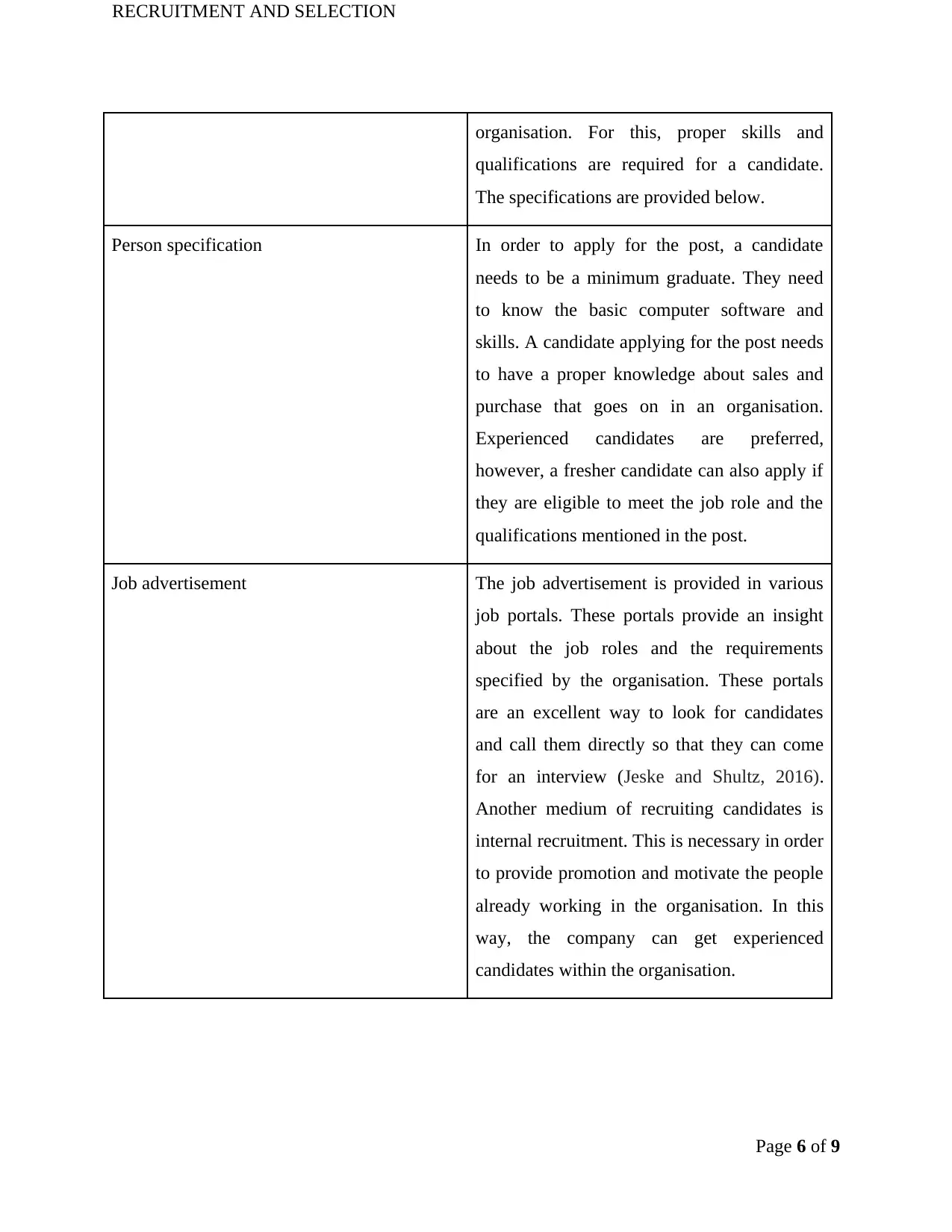
RECRUITMENT AND SELECTION
organisation. For this, proper skills and
qualifications are required for a candidate.
The specifications are provided below.
Person specification In order to apply for the post, a candidate
needs to be a minimum graduate. They need
to know the basic computer software and
skills. A candidate applying for the post needs
to have a proper knowledge about sales and
purchase that goes on in an organisation.
Experienced candidates are preferred,
however, a fresher candidate can also apply if
they are eligible to meet the job role and the
qualifications mentioned in the post.
Job advertisement The job advertisement is provided in various
job portals. These portals provide an insight
about the job roles and the requirements
specified by the organisation. These portals
are an excellent way to look for candidates
and call them directly so that they can come
for an interview (Jeske and Shultz, 2016).
Another medium of recruiting candidates is
internal recruitment. This is necessary in order
to provide promotion and motivate the people
already working in the organisation. In this
way, the company can get experienced
candidates within the organisation.
Page 6 of 9
organisation. For this, proper skills and
qualifications are required for a candidate.
The specifications are provided below.
Person specification In order to apply for the post, a candidate
needs to be a minimum graduate. They need
to know the basic computer software and
skills. A candidate applying for the post needs
to have a proper knowledge about sales and
purchase that goes on in an organisation.
Experienced candidates are preferred,
however, a fresher candidate can also apply if
they are eligible to meet the job role and the
qualifications mentioned in the post.
Job advertisement The job advertisement is provided in various
job portals. These portals provide an insight
about the job roles and the requirements
specified by the organisation. These portals
are an excellent way to look for candidates
and call them directly so that they can come
for an interview (Jeske and Shultz, 2016).
Another medium of recruiting candidates is
internal recruitment. This is necessary in order
to provide promotion and motivate the people
already working in the organisation. In this
way, the company can get experienced
candidates within the organisation.
Page 6 of 9
⊘ This is a preview!⊘
Do you want full access?
Subscribe today to unlock all pages.

Trusted by 1+ million students worldwide
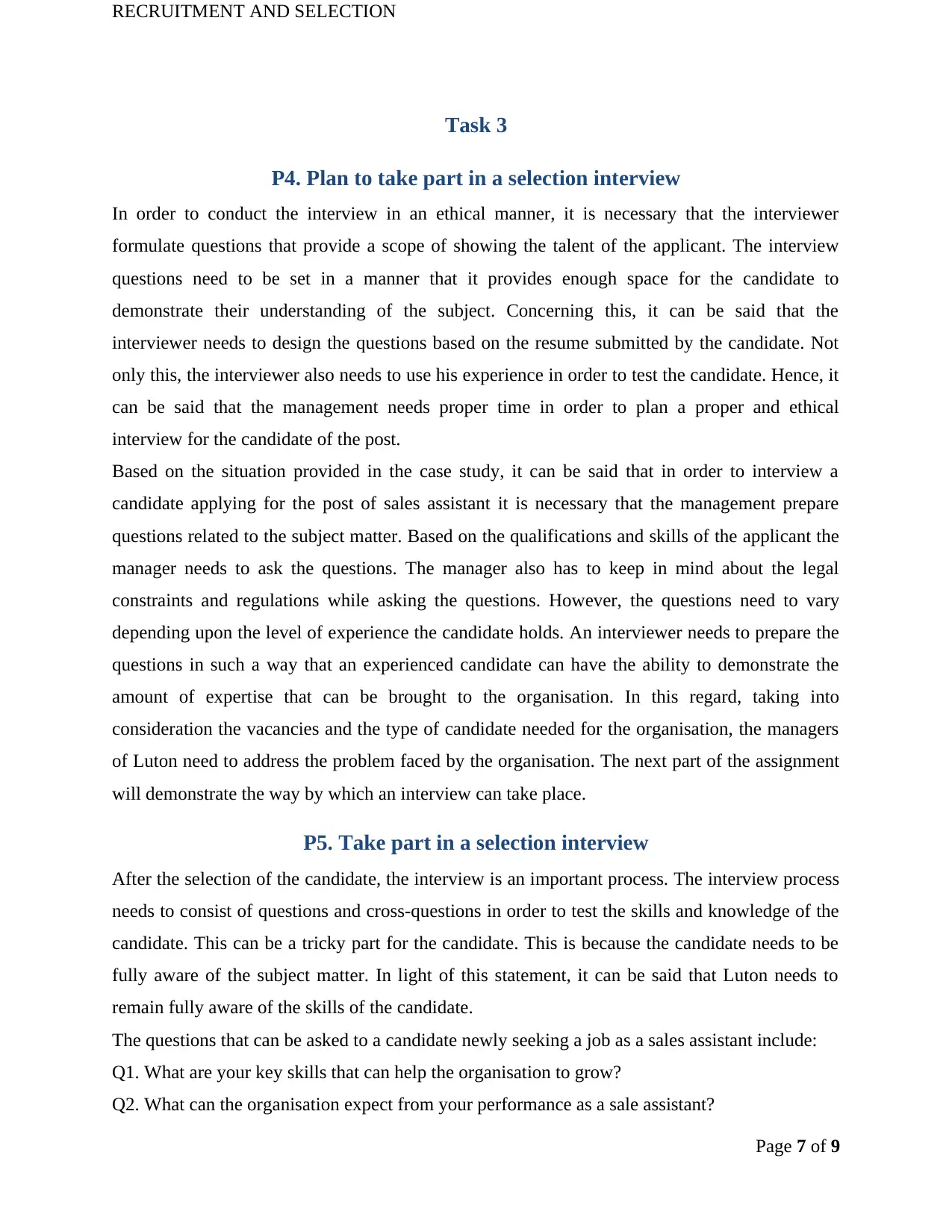
RECRUITMENT AND SELECTION
Task 3
P4. Plan to take part in a selection interview
In order to conduct the interview in an ethical manner, it is necessary that the interviewer
formulate questions that provide a scope of showing the talent of the applicant. The interview
questions need to be set in a manner that it provides enough space for the candidate to
demonstrate their understanding of the subject. Concerning this, it can be said that the
interviewer needs to design the questions based on the resume submitted by the candidate. Not
only this, the interviewer also needs to use his experience in order to test the candidate. Hence, it
can be said that the management needs proper time in order to plan a proper and ethical
interview for the candidate of the post.
Based on the situation provided in the case study, it can be said that in order to interview a
candidate applying for the post of sales assistant it is necessary that the management prepare
questions related to the subject matter. Based on the qualifications and skills of the applicant the
manager needs to ask the questions. The manager also has to keep in mind about the legal
constraints and regulations while asking the questions. However, the questions need to vary
depending upon the level of experience the candidate holds. An interviewer needs to prepare the
questions in such a way that an experienced candidate can have the ability to demonstrate the
amount of expertise that can be brought to the organisation. In this regard, taking into
consideration the vacancies and the type of candidate needed for the organisation, the managers
of Luton need to address the problem faced by the organisation. The next part of the assignment
will demonstrate the way by which an interview can take place.
P5. Take part in a selection interview
After the selection of the candidate, the interview is an important process. The interview process
needs to consist of questions and cross-questions in order to test the skills and knowledge of the
candidate. This can be a tricky part for the candidate. This is because the candidate needs to be
fully aware of the subject matter. In light of this statement, it can be said that Luton needs to
remain fully aware of the skills of the candidate.
The questions that can be asked to a candidate newly seeking a job as a sales assistant include:
Q1. What are your key skills that can help the organisation to grow?
Q2. What can the organisation expect from your performance as a sale assistant?
Page 7 of 9
Task 3
P4. Plan to take part in a selection interview
In order to conduct the interview in an ethical manner, it is necessary that the interviewer
formulate questions that provide a scope of showing the talent of the applicant. The interview
questions need to be set in a manner that it provides enough space for the candidate to
demonstrate their understanding of the subject. Concerning this, it can be said that the
interviewer needs to design the questions based on the resume submitted by the candidate. Not
only this, the interviewer also needs to use his experience in order to test the candidate. Hence, it
can be said that the management needs proper time in order to plan a proper and ethical
interview for the candidate of the post.
Based on the situation provided in the case study, it can be said that in order to interview a
candidate applying for the post of sales assistant it is necessary that the management prepare
questions related to the subject matter. Based on the qualifications and skills of the applicant the
manager needs to ask the questions. The manager also has to keep in mind about the legal
constraints and regulations while asking the questions. However, the questions need to vary
depending upon the level of experience the candidate holds. An interviewer needs to prepare the
questions in such a way that an experienced candidate can have the ability to demonstrate the
amount of expertise that can be brought to the organisation. In this regard, taking into
consideration the vacancies and the type of candidate needed for the organisation, the managers
of Luton need to address the problem faced by the organisation. The next part of the assignment
will demonstrate the way by which an interview can take place.
P5. Take part in a selection interview
After the selection of the candidate, the interview is an important process. The interview process
needs to consist of questions and cross-questions in order to test the skills and knowledge of the
candidate. This can be a tricky part for the candidate. This is because the candidate needs to be
fully aware of the subject matter. In light of this statement, it can be said that Luton needs to
remain fully aware of the skills of the candidate.
The questions that can be asked to a candidate newly seeking a job as a sales assistant include:
Q1. What are your key skills that can help the organisation to grow?
Q2. What can the organisation expect from your performance as a sale assistant?
Page 7 of 9
Paraphrase This Document
Need a fresh take? Get an instant paraphrase of this document with our AI Paraphraser
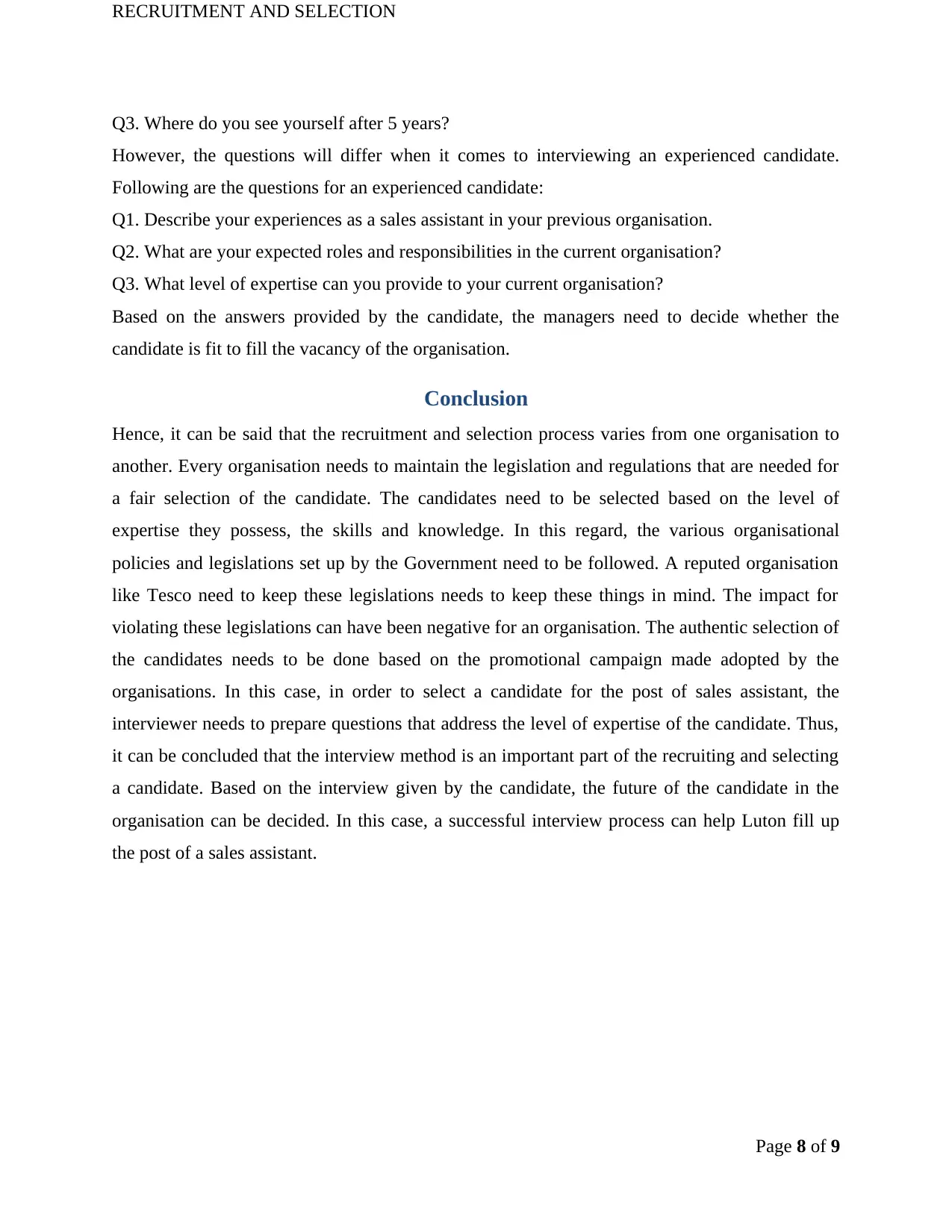
RECRUITMENT AND SELECTION
Q3. Where do you see yourself after 5 years?
However, the questions will differ when it comes to interviewing an experienced candidate.
Following are the questions for an experienced candidate:
Q1. Describe your experiences as a sales assistant in your previous organisation.
Q2. What are your expected roles and responsibilities in the current organisation?
Q3. What level of expertise can you provide to your current organisation?
Based on the answers provided by the candidate, the managers need to decide whether the
candidate is fit to fill the vacancy of the organisation.
Conclusion
Hence, it can be said that the recruitment and selection process varies from one organisation to
another. Every organisation needs to maintain the legislation and regulations that are needed for
a fair selection of the candidate. The candidates need to be selected based on the level of
expertise they possess, the skills and knowledge. In this regard, the various organisational
policies and legislations set up by the Government need to be followed. A reputed organisation
like Tesco need to keep these legislations needs to keep these things in mind. The impact for
violating these legislations can have been negative for an organisation. The authentic selection of
the candidates needs to be done based on the promotional campaign made adopted by the
organisations. In this case, in order to select a candidate for the post of sales assistant, the
interviewer needs to prepare questions that address the level of expertise of the candidate. Thus,
it can be concluded that the interview method is an important part of the recruiting and selecting
a candidate. Based on the interview given by the candidate, the future of the candidate in the
organisation can be decided. In this case, a successful interview process can help Luton fill up
the post of a sales assistant.
Page 8 of 9
Q3. Where do you see yourself after 5 years?
However, the questions will differ when it comes to interviewing an experienced candidate.
Following are the questions for an experienced candidate:
Q1. Describe your experiences as a sales assistant in your previous organisation.
Q2. What are your expected roles and responsibilities in the current organisation?
Q3. What level of expertise can you provide to your current organisation?
Based on the answers provided by the candidate, the managers need to decide whether the
candidate is fit to fill the vacancy of the organisation.
Conclusion
Hence, it can be said that the recruitment and selection process varies from one organisation to
another. Every organisation needs to maintain the legislation and regulations that are needed for
a fair selection of the candidate. The candidates need to be selected based on the level of
expertise they possess, the skills and knowledge. In this regard, the various organisational
policies and legislations set up by the Government need to be followed. A reputed organisation
like Tesco need to keep these legislations needs to keep these things in mind. The impact for
violating these legislations can have been negative for an organisation. The authentic selection of
the candidates needs to be done based on the promotional campaign made adopted by the
organisations. In this case, in order to select a candidate for the post of sales assistant, the
interviewer needs to prepare questions that address the level of expertise of the candidate. Thus,
it can be concluded that the interview method is an important part of the recruiting and selecting
a candidate. Based on the interview given by the candidate, the future of the candidate in the
organisation can be decided. In this case, a successful interview process can help Luton fill up
the post of a sales assistant.
Page 8 of 9

RECRUITMENT AND SELECTION
Reference List
Armstrong, M. and Taylor, S., (2014). Armstrong's handbook of human resource management
practice. Boston: Kogan Page Publishers.
Bryson, J., James, S. and Keep, E., (2013). Recruitment and selection. Managing human
resources. Human Resource Management in transition, pp.125-149.
Dickmann, M., Brewster, C. and Sparrow, P. eds., (2016). International Human Resource
Management: Contemporary HR Issues in Europe. London: Routledge.
Jeske, D. and Shultz, K.S., (2016). Using social media content for screening in recruitment and
selection: pros and cons. Work, Employment & Society, 30(3), pp.535-546.
Lievens, F., (2015). Diversity in medical school admission: insights from personnel recruitment
and selection. Medical education, 49(1), pp.11-14.
Newell, S., (2015). Recruitment and selection. Managing human resources: personnel
management in transition, pp.115-147.
Shackleton, V., (2015). Recruitment and Selection. Elements of Applied Psychology, p.153.
Taylor, S., (2014). Recruitment and selection. Strategic Human Resource Management: An
International Perspective, 10(6), pp.139-14.
Wilton, N., (2016). An introduction to human resource management. Boston: Sage.
Page 9 of 9
Reference List
Armstrong, M. and Taylor, S., (2014). Armstrong's handbook of human resource management
practice. Boston: Kogan Page Publishers.
Bryson, J., James, S. and Keep, E., (2013). Recruitment and selection. Managing human
resources. Human Resource Management in transition, pp.125-149.
Dickmann, M., Brewster, C. and Sparrow, P. eds., (2016). International Human Resource
Management: Contemporary HR Issues in Europe. London: Routledge.
Jeske, D. and Shultz, K.S., (2016). Using social media content for screening in recruitment and
selection: pros and cons. Work, Employment & Society, 30(3), pp.535-546.
Lievens, F., (2015). Diversity in medical school admission: insights from personnel recruitment
and selection. Medical education, 49(1), pp.11-14.
Newell, S., (2015). Recruitment and selection. Managing human resources: personnel
management in transition, pp.115-147.
Shackleton, V., (2015). Recruitment and Selection. Elements of Applied Psychology, p.153.
Taylor, S., (2014). Recruitment and selection. Strategic Human Resource Management: An
International Perspective, 10(6), pp.139-14.
Wilton, N., (2016). An introduction to human resource management. Boston: Sage.
Page 9 of 9
⊘ This is a preview!⊘
Do you want full access?
Subscribe today to unlock all pages.

Trusted by 1+ million students worldwide
1 out of 9
Related Documents
Your All-in-One AI-Powered Toolkit for Academic Success.
+13062052269
info@desklib.com
Available 24*7 on WhatsApp / Email
![[object Object]](/_next/static/media/star-bottom.7253800d.svg)
Unlock your academic potential
Copyright © 2020–2025 A2Z Services. All Rights Reserved. Developed and managed by ZUCOL.





